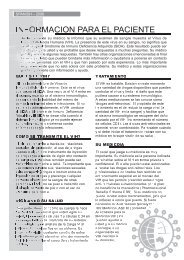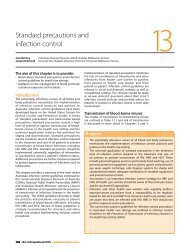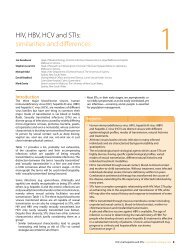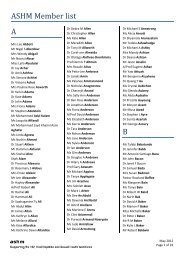B Positive – all you wanted to know about - ASHM
B Positive – all you wanted to know about - ASHM
B Positive – all you wanted to know about - ASHM
You also want an ePaper? Increase the reach of your titles
YUMPU automatically turns print PDFs into web optimized ePapers that Google loves.
Foreword<br />
in nsW, just seven cancers—those of prostate, breast, bowel, lung, melanoma and non-<br />
Hodgkin’s lymphoma, and cancers of un<strong>know</strong>n site—account for 68% of <strong>all</strong> cancers. in turn,<br />
they account for 60% of cancer deaths. the national response <strong>to</strong> cancer is quite rightly focused<br />
on these seven cancers.<br />
However, what is true for the population taken as a whole may not be true for <strong>all</strong> subgroups of<br />
that population. the cancer council nsW report Cancer Incidence in New South Wales Migrants<br />
1991-2001 demonstrates that migrants from some countries have quite a different cancer<br />
profile from that of the australian-born population. 1 Liver cancer is a case in point. although the<br />
over<strong>all</strong> share of cancer in nsW migrants (24.5%) is commensurate with their representation in<br />
the population, 46% of <strong>all</strong> primary liver cancers in nsW are diagnosed in overseas-born people.<br />
there are several striking features in the epidemiology of liver cancer in nsW. firstly, it is the<br />
most rapidly increasing of <strong>all</strong> cancers. between 1995 and 2004, primary liver cancer in nsW<br />
increased by 59% in males and 116% in females. secondly, it is among the most fatal cancer,<br />
with a five-year relative survival of 15% akin <strong>to</strong> that of lung and pancreatic cancer. thirdly, in<br />
comparison <strong>to</strong> the australian-born population, immigrants from countries with high prevalence<br />
rates for chronic hepatitis b virus (HbV) infection are at a sixfold or greater risk of developing<br />
liver cancer. in nsW, liver cancer exhibits a striking pattern of geographic clustering, reflecting<br />
in part differences in neighbourhood ethnic composition.<br />
People with chronic HbV infection incur a high burden of chronic disease and premature death.<br />
around 30% will die of liver cancer or liver disease. the population at risk will continue <strong>to</strong> swell as<br />
immigration from HbV endemic countries continues and increases, and it will be some decades<br />
before universal infant HbV vaccination programs in those countries substanti<strong>all</strong>y reduce the<br />
rates of chronicity in adult populations. this situation poses a ch<strong>all</strong>enge <strong>to</strong> the convenient notion<br />
that australia’s program of universal childhood vaccination and protection of the blood supply<br />
are a sufficient response. Presently, there is no systematic approach <strong>to</strong> vaccinating susceptible<br />
people within high-risk communities.<br />
the difference between australia’s response <strong>to</strong> hepatitis b and the national Hepatitis c strategy<br />
is dramatic. in stark contrast <strong>to</strong> the patchy and unfocused response <strong>to</strong> HbV, the management<br />
of hepatitis c includes a comprehensive response based on building partnerships; involving<br />
affected communities; preventing hepatitis c virus (HcV) transmission; providing clinical<br />
treatment, and community care and support <strong>to</strong> those with the infection; providing training and<br />
education; and undertaking research and disease surveillance.<br />
a systematic response <strong>to</strong> HbV is both feasible and affordable. the long latency period between<br />
childhood HbV infection and the development of liver-related disease provides an ample<br />
window of opportunity for case finding, especi<strong>all</strong>y among <strong>know</strong>n high-risk groups. Moni<strong>to</strong>ring<br />
6 b <strong>Positive</strong> <strong>–</strong> <strong>all</strong> <strong>you</strong> <strong>wanted</strong> <strong>to</strong> <strong>know</strong> <strong>about</strong> hepatitis b: a guide for primary care providers






